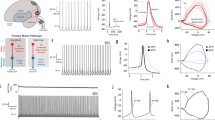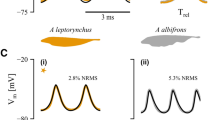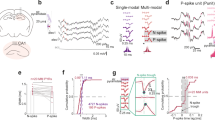Abstract
Aglantha digitale is a jellyfish (order Hydromedusae) capable of two distinct kinds of locomotion; ‘slow’ swimming which is gener ated endogenously and is used in fishing behaviour, and ‘fast’ swimming which is evoked by predators and serves for escape. Both forms of swimming are produced by contraction of the bell-shaped body wall and expulsion of a jet of water from an opening at the base of the animal. During slow swimming, the contractions are weak and the animal moves about 15 mm, roughly one body length, but during a fast swim there is a more violent contraction which can propel the animal five times as far1,2. Both forms of contraction depend on impulses in the eight giant motor axons that synapse directly with the muscle sheet making up the inner surface of the body wall3,4. We report here that the giant motor axons are able to mediate both kinds of activity because they can conduct two different sorts of impulse. Fast swimming requires a rapidly con ducted Na+-dependent action potential whereas slow swimming depends on a low amplitude Ca2+ ‘spike’. This is the first report of an axon capable of two kinds of impulse propagation and it provides a physiological function for low potential Ca2+ activation5.
This is a preview of subscription content, access via your institution
Access options
Subscribe to this journal
Receive 51 print issues and online access
$199.00 per year
only $3.90 per issue
Buy this article
- Purchase on Springer Link
- Instant access to full article PDF
Prices may be subject to local taxes which are calculated during checkout
Similar content being viewed by others
References
Mackie, G.O. Can. J. Fish. aquat. Sci. 37, 1550–1556 (1980).
Donaldson, S., Mackie, G. O. & Roberts, A. Can. J. Zool. 58, 549–552 (1980).
Singla, C. L. Cell Tissue Res. 188, 317–327 (1978).
Roberts, A. & Mackie, G. O. J. exp. Biol. 84, 303–318 (1980).
Hagiwara, S., Ozawa, S. & Sand, O. J. gen. Physiol. 65, 617–644 (1975).
Satterlie, R. A. & Spencer, A. N. J. comp. Physiol. A150, 195–206 (1983).
Weber, C., Singla, C. L. & Kerfoot, P. A. H. Cell Tissue Res. 223, 305–312 (1982).
Kerfoot, P. A. H., Mackie, G. O., Meech, R. W., Roberts, A. & Singla, C. L. J. exp. Biol. (in the press).
Hagiwara, S. & Takahashi, K. J. gen. Physiol. 50, 583–601 (1967).
Fleckenstein, A. A. Rev. Pharmac. Tox. 17, 149–166 (1977).
Hodgkin, A. L. & Katz, B. J. Physiol., Lond. 108, 37–77 (1949).
Tillotson, D. Proc. natn. Acad. Sci. U.S.A. 76, 1497–1500 (1979).
Fox, A. P. Proc. natn. Acad. Sci. U.S.A. 78, 953–956 (1981).
Deitmer, J. W. J. Physiol., Lond. 355, 137–159 (1984).
Halliwell, J. V. J. Physiol., Lond. 341, 10P (1983).
Carbone, E. & Lux, H. D. Nature 310, 501–502 (1984).
Bossu, J.-L., Feltz, A. & Thomann, J.-M. J. Physiol., Lond. 358, 72P (1985).
Llinás, R. & Yarom, Y. J. Physiol., Lond. 315, 569–584 (1981).
Llinás, R. & Jahnsen, H. Nature 297, 406–408 (1982).
Author information
Authors and Affiliations
Rights and permissions
About this article
Cite this article
Mackie, G., Meech, R. Separate sodium and calcium spikes in the same axon. Nature 313, 791–793 (1985). https://doi.org/10.1038/313791a0
Received:
Accepted:
Issue Date:
DOI: https://doi.org/10.1038/313791a0
This article is cited by
-
Cav3 T-type channels: regulators for gating, membrane expression, and cation selectivity
Pflügers Archiv - European Journal of Physiology (2014)
-
Impulse conduction in the jellyfish Aglantha digitale
Hydrobiologia (2004)
-
Cnidarian neurobiology: what does the future hold?
Hydrobiologia (2004)
-
Structure of a putative sodium channel from the sea anemoneAiptasia pallida
Invertebrate Neuroscience (1998)
-
Broad minded on narrow spikes
Nature (1989)
Comments
By submitting a comment you agree to abide by our Terms and Community Guidelines. If you find something abusive or that does not comply with our terms or guidelines please flag it as inappropriate.



